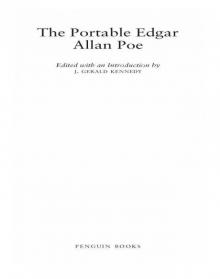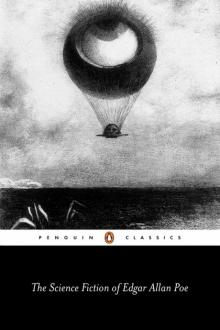- Home
- Edgar Allan Poe
The Science Fiction of Edgar Allan Poe (Penguin Classics) Page 28
The Science Fiction of Edgar Allan Poe (Penguin Classics) Read online
Page 28
But in spite of this confirmation of that which needed none – in spite of the so-called corroboration of the ‘theory’ by the so-called ‘ocular and physical proof’ – in spite of the character of this corroboration – the ideas which even really philosophical men cannot help imbibing of Gravity – and, especially, the ideas of it which ordinary men get and contentedly maintain, are seen to have been derived, for the most part, from a consideration of the principle as they find it developed – merely in the planet on which they stand.
Now, to what does so partial a consideration tend – to what species of error does it give rise? On the Earth we see and feel, only that Gravity impels all bodies towards the centre of the Earth. No man in the common walks of life could be made to see or feel anything else – could be made to perceive that anything, anywhere, has a perpetual, gravitating tendency in any other direction than to the centre of the Earth; yet (with an exception hereafter to be specified) it is a fact that every earthly thing (not to speak now of every heavenly thing) has a tendency not only to the Earth’s centre but in every conceivable direction besides.
Now, although the philosophic cannot be said to err with the vulgar in this matter, they nevertheless permit themselves to be influenced, without knowing it, by the sentiment of the vulgar idea. ‘Although the Pagan fables are not believed,’ says Bryant, in his very erudite ‘Mythology’,21 ‘yet we forget ourselves continually and make inferences from them as from existing realities.’ I mean to assert that the merely sensitive perception of Gravity as we experience it on Earth, beguiles mankind into the fancy of concentralization or especiality respecting it – has been continually biasing towards this fancy even the mightiest intellects – perpetually, although imperceptibly, leading them away from the real characteristics of the principle; thus preventing them, up to this date, from ever getting a glimpse of that vital truth which lies in a diametrically opposite direction – behind the principle’s essential characteristics – those, not of concentralization or especiality – but of universality and diffusion. This ‘vital truth’ is Unity as the source of the phænomenon.
Let me now repeat the definition of Gravity : – Every atom, of every body, attracts every other atom, both of its own and of every other body, with a force which varies inversely as the squares of the distances of the attracting and attracted atom.
Here let the reader pause with me, for a moment, in contemplation of the miraculous – of the ineffable – of the altogether unimaginable complexity of relation involved in the fact that each atom attracts every other atom – involved merely in this fact of the Attraction, without reference to the law or mode in which the Attraction is manifested – involved merely in the fact that each atom attracts every other atom at all, in a wilderness of atoms so numerous that those which go to the composition of a cannon-ball, exceed, probably, in mere point of number, all the stars which go to the constitution of the Universe.
Had we discovered, simply, that each atom tends to some one point, a favorite with all – to some especially attractive atom – we should still have fallen upon a discovery which, in itself, would have sufficed to overwhelm the mind: – but what is it that we are actually called on to comprehend? That each atom attracts – sympathizes with the most delicate movements of every other atom, and with each and with all at the same time, and forever, and according to a determinate law of which the complexity, even considered by itself solely, is utterly beyond the grasp of the imagination. If I propose to ascertain the influence of one mote in a sunbeam on its neighboring mote,22 I cannot accomplish my purpose without first counting and weighing all the atoms in the Universe and defining the precise positions of all at one particular moment. If I venture to displace, by even the billionth part of an inch, the microscopical speck of dust which lies now on the point of my finger, what is the character of that act upon which I have adventured? I have done a deed which shakes the Moon in her path,23 which causes the Sun to be no longer the Sun, and which alters forever the destiny of the multitudinous myriads of stars that roll and glow in the majestic presence of their Creator.
These ideas – conceptions such as these – unthought-like thoughts – soul-reveries rather than conclusions or even considerations of the intellect: – ideas, I repeat, such as these, are such as we can alone hope profitably to entertain in any effort at grasping the great principle, Attraction.
But now, – with such ideas – with such a vision of the marvellous complexity of Attraction fairly in his mind – let any person competent of thought on such topics as these, set himself to the task of imagining a principle for the phænomena observed – a condition from which they sprang.
Does not so evident a brotherhood among the atoms point to a common parentage? Does not a sympathy so omniprevalent, so ineradicable, and so thoroughly irrespective, suggest a common paternity as its source? Does not one extreme impel the reason to the other? Does not the infinitude of division refer to the utterness of individuality? Does not the entireness of the complex hint at the perfection of the simple? It is not that the atoms, as we see them, are divided or that they are complex in their relations – but that they are inconceivably divided and unutterably complex: – it is the extremeness of the conditions to which I now allude, rather than to the conditions themselves. In a word, not because the atoms were, at some remote epoch of time, even more than together – is it not because originally, and therefore normally, they were One – that now, in all circumstances – at all points – in all directions – by all modes of approach – in all relations and through all conditions – they struggle back to this absolutely, this irrelatively, this unconditionally One?
Some person may here demand: – ‘Why – since it is to the One that the atoms struggle back – do we not find and define Attraction “as merely general tendency to a centre?” – why, in especial, do not your atoms – the atoms which you describe as having been radiated from a centre – proceed at once, rectilinearly, back to the central point of their origin?’
I reply that they do; as will be distinctly shown; but that the cause of their so doing is quite irrespective of the centre as such. They all tend rectilinearly towards a centre, because of the sphericity with which they have been radiated into space. Each atom, forming one of a generally uniform globe of atoms, finds more atoms in the direction of the centre, of course, than in any other, and in that direction, therefore, is impelled – but is not thus impelled because the centre is the point of its origin. It is not to any point that the atoms are allied. It is not any locality, either in the concrete or in the abstract, to which I suppose them bound. Nothing like location was conceived as their origin. Their source lies in the principle, Unity. This is their lost parent. This they seek always – immediately – in all directions – wherever it is even partially to be found; thus appeasing, in some measure, the ineradicable tendency, while on the way to its absolute satisfaction in the end. It follows from all this, that any principle which shall be adequate to account for the law, or modus operandi, of the attractive force in general, will account for this law in particular : – that is to say, any principle which will show why the atoms should tend to their general centre of radiation with forces inversely proportional with the squares of the distances, will be admitted as satisfactorily accounting, at the same time, for the tendency, according to the same law, of these atoms each to each: – for the tendency to the centre is merely the tendency each to each, and not any tendency to a centre as such. – Thus it will be seen, also, that the establishment of my propositions would involve no necessity of modification in the terms of the Newtonian definition of Gravity, which declares that each atom attracts each other atom and so forth, and declares this merely; but (always under the supposition that what I propose be, in the end, admitted) it seems clear that some error might occasionally be avoided, in the future processes of Science, were a more ample phraseology adopted: – for instance : – ‘Each atom tends to every other atom &c. with a force &c.: the general result being a tenden
cy of all, with a similar force, to a general centre.’
The reversal of our processes has thus brought us to an identical result; but, while in the one process Intuition was the starting-point, in the other it was the goal. In commencing the former journey I could only say that, with an irresistible Intuition, I felt Simplicity to have been the characteristic of the original action of God: – in ending the latter I can only declare that, with an irresistible intuition, I perceive Unity to have been the source of the observed phænomena of the Newtonian Gravity. Thus, according to the schools, I prove nothing. So be it: – I design but to suggest – and to convince through the suggestion. I am proudly aware that there exist many of the most profound and cautiously discriminative intellects which cannot help being abundantly content with my – suggestions. To these intellects – as to my own – there is no mathematical demonstration which could bring the least additional true proof of the great Truth which I have advanced – the truth of Original Unity as the source – as the principle of the Universal Phœnomena. For my part, I am not sure that I speak and see – I am not so sure that my heart beats and that my soul lives: – of the rising of to-morrow’s sun – a probability that as yet lies in the Future – I do not pretend to be one thousandth part as sure – as I am of the irretrievably by-gone Fact that All Things and All Thoughts of Things, with all their ineffable Multiplicity of Relation, sprang at once into being from the primordial and irrelative One.
Referring to the Newtonian Gravity, Dr Nichol, the eloquent author of ‘The Architecture of the Heavens’,24 says:– ‘In truth we have no reason to suppose this great Law, as now revealed, to be the ultimate or simplest, and therefore the universal and all-comprehensive, form of a great Ordinance. The mode in which its intensity diminishes with the element of distance, has not the aspect of an ultimate principle; which always assumes the simplicity and self-evidence of those axioms which constitute the basis of Geometry.’
Now, it is quite true that ‘ultimate principles’, in the common understanding of the words, always assume the simplicity of geometrical axioms – (as for ‘self-evidence’, there is no such thing) – but these principles are clearly not ‘ultimate’; in other terms what we are in the habit of calling principles are no principles, properly speaking – since there can be but one principle, the Volition of God. We have no right to assume, then, from what we observe in rules that we choose foolishly to name ‘principles’, anything at all in respect to the characteristics of a principle proper. The ‘ultimate principles’ of which Dr Nichol speaks as having geometrical simplicity, may and do have this geometrical turn, as being part and parcel of a vast geometrical system, and thus a system of simplicity itself – in which, nevertheless, the truly ultimate principle is, as we know, the consummation of the complex – that is to say, of the unintelligible – for is it not the Spiritual Capacity of God?
I quoted Dr Nichol’s remark, however, not so much to question its philosophy, as by way of calling attention to the fact that, while all men have admitted some principle as existing behind the Law of Gravity, no attempt has been yet made to point out what this principle in particular is: – if we except, perhaps, occasional fantastic efforts at referring it to Magnetism, or Mesmerism, or Swedenborgianism, or Transcendentalism, or some other equally delicious ism of the same species, and invariably patronized by one and the same species of people. The great mind of Newton, while boldly grasping the Law itself, shrank from the principle of the Law. The more fluent and comprehensive at least, if not the more patient and profound, sagacity of Laplace, had not the courage to attack it. But hesitation on the part of these two astronomers it is, perhaps, not so very difficult to understand. They, as well as all the first class of mathematicians, were mathematicians solely: – their intellect, at least, had a firmly-pronounced mathematico-physical tone. What lay not distinctly within the domain of Physics, or of Mathematics, seemed to them either Non-Entity or Shadow. Nevertheless, we may well wonder that Leibnitz, who was a marked exception to the general rule in these respects, and whose mental temperament was a singular admixture of the mathematical with the physico-metaphysical, did not at once investigate and establish the point at issue. Either Newton or Laplace, seeking a principle and discovering none physical, would have rested contentedly in the conclusion that there was absolutely none; but it is almost impossible to fancy, of Leibnitz, that, having exhausted in his search the physical dominions, he would not have stepped at once, boldly and hopefully, amid his old familiar haunts in the kingdom of Metaphysics. Here, indeed, it is clear that he must have adventured in search of the treasure: – that he did not find it after all, was, perhaps, because his fairy guide, Imagination, was not sufficiently well-grown, or well-educated, to direct him aright.
I observed, just now, that, in fact, there had been certain vague attempts at referring Gravity to some very uncertain isms. These attempts, however, although considered bold and justly so considered, looked no farther than to the generality – the merest generality – of the Newtonian Law. Its modus operandi has never, to my knowledge, been approached in the way of an effort at explanation. It is, therefore, with no unwarranted fear of being taken for a madman at the outset, and before I can bring my propositions fairly to the eye of those who alone are competent to decide on them, that I here declare the modus operandi of the Law of Gravity to be an exceedingly simple and perfectly explicable thing 25 – that is to say, when we make our advances towards it in just gradations and in the true direction – when we regard it from the proper point of view.
Whether we reach the idea of absolute Unity as the source of All Things, from a consideration of Simplicity as the most probable characteristic of the original action of God; – whether we arrive at it from an inspection of the universality of relation in the gravitating phænomena; – or whether we attain it as a result of the mutual corroboration afforded by both processes; – still, the idea itself, if entertained at all, is entertained in inseparable connection with another idea – that of the condition of the Universe of Stars as we now perceive it – that is to say, a condition of immeasurable diffusion through space. Now a connection between these two ideas – unity and diffusion – cannot be established unless through the entertainment of a third idea – that of radiation. Absolute Unity being taken as a centre, then the existing Universe of Stars is the result of radiation from that centre.
Now, the laws of radiation are known. They are part and parcel of the sphere. They belong to the class of indisputable geometrical properties. We say of them, ‘they are true – they are evident’. To demand why they are true, would be to demand why the axioms are true upon which their demonstration is based. Nothing is demonstrable, strictly speaking; but if anything be, then the properties – the laws in question are demonstrated.
But these laws – what do they declare? Radiation – how – by what steps does it proceed outwardly from a centre?
From a luminous centre, Light issues by radiation; and the quantities of light received upon any given plane, supposed to be shifting its position so as to be now nearer the centre and now farther from it, will be diminished in the same proportion as the squares of the distances of the plane from the luminous body, are increased; and will be increased in the same proportion as these squares are diminished.
The expression of the law may be thus generalized: – the number of light-particles (or, if the phrase be preferred, the number of light-impressions) received upon the shifting plane, will be inversely proportional with the squares of the distances of the plane. Generalizing yet again, we may say that the diffusion – the scattering – the radiation, in a word – is directly proportional with the squares of the distances.
For example: at the distance B, from the luminous centre A, a certain number of particles are so diffused as to occupy the surface B. Then at double the distance – that is to say
at C – they will be so much farther diffused as to occupy four such surfaces : – at treble the distance, or at D, they will be so much
farther separated as to occupy nine such surface : – while, at quadruple the distance, or at E, they will have become so scattered as to spread themselves over sixteen such surfaces – and so on forever.
In saying, generally, that the radiation proceeds in direct proportion with the squares of the distances, we use the term radiation to express the degree of the diffusion as we proceed outwardly from the centre. Conversing the idea, and employing the word ‘concentralization’ to express the degree of the drawing together as we come back toward the centre from an outward position, we may say that concentralization proceeds inversely as the squares of the distances. In other words, we have reached the conclusion that, on the hypothesis that matter was originally radiated from a centre and is now returning to it, the concentralization, in the return, proceeds exactly as we know the force of gravitation to proceed.
Now here, if we could be permitted to assume that concentralization exactly represents the force of the tendency to the centre – that the one is exactly proportional with the other, and that the two proceed together – we should have shown all that is required. The sole difficulty existing, then, is to establish a direct proportion between ‘concentralization’ and the force of concentralization; and this is done, of course, if we establish such proportion between ‘radiation’ and the force of radiation.

 The Works of Edgar Allan Poe — Volume 2
The Works of Edgar Allan Poe — Volume 2 The Works of Edgar Allan Poe — Volume 1
The Works of Edgar Allan Poe — Volume 1 The Works of Edgar Allan Poe — Volume 3
The Works of Edgar Allan Poe — Volume 3 The Works of Edgar Allan Poe — Volume 5
The Works of Edgar Allan Poe — Volume 5 The Works of Edgar Allan Poe — Volume 4
The Works of Edgar Allan Poe — Volume 4 The Tell-Tale Heart
The Tell-Tale Heart The Raven (Penguin)
The Raven (Penguin) The Paris Mysteries
The Paris Mysteries Tales of Terror from Edgar Allan Poe
Tales of Terror from Edgar Allan Poe The Fall of the House of Usher
The Fall of the House of Usher The Golden Book of World's Greatest Mysteries
The Golden Book of World's Greatest Mysteries The Narrative of Arthur Gordon Pym of Nantucket
The Narrative of Arthur Gordon Pym of Nantucket Ligeia
Ligeia The Landscape Garden
The Landscape Garden Complete Tales & Poems
Complete Tales & Poems Great Tales and Poems of Edgar Allan Poe
Great Tales and Poems of Edgar Allan Poe The Colloquy of Monos and Una
The Colloquy of Monos and Una The Oblong Box
The Oblong Box Thou Art the Man
Thou Art the Man A DESCENT INTO THE MAELSTROM
A DESCENT INTO THE MAELSTROM THE MURDERS IN THE RUE MORGUE
THE MURDERS IN THE RUE MORGUE The Business Man
The Business Man The Mystery of Marie Rogêt
The Mystery of Marie Rogêt Metzengerstein
Metzengerstein The Man That Was Used Up
The Man That Was Used Up William Wilson
William Wilson The Philosophy of Composition
The Philosophy of Composition The Portable Edgar Allan Poe
The Portable Edgar Allan Poe Bon-Bon
Bon-Bon A Predicament
A Predicament The Premature Burial
The Premature Burial The Angel of the Odd
The Angel of the Odd The Man of the Crowd
The Man of the Crowd Never Bet the Devil Your Head
Never Bet the Devil Your Head The Tell-Tale Heart and Other Writings
The Tell-Tale Heart and Other Writings The System of Doctor Tarr and Professor Fether
The System of Doctor Tarr and Professor Fether Selected Tales (Oxford World's Classics)
Selected Tales (Oxford World's Classics) Essential Tales and Poems of Edgar Allan Poe (Barnes & Noble Classics Series)
Essential Tales and Poems of Edgar Allan Poe (Barnes & Noble Classics Series) MS. Found in a Bottle
MS. Found in a Bottle Some Words with a Mummy
Some Words with a Mummy The Science Fiction of Edgar Allan Poe (Penguin Classics)
The Science Fiction of Edgar Allan Poe (Penguin Classics) King Pest
King Pest CRITICISM
CRITICISM How to Write a Blackwood Article
How to Write a Blackwood Article Mystification
Mystification Diddling Considered as One of the Exact Sciences
Diddling Considered as One of the Exact Sciences Steampunk Poe
Steampunk Poe The Literary Life of Thingum Bob, Esq.
The Literary Life of Thingum Bob, Esq. Classic Crime Collection
Classic Crime Collection Complete Stories and Poems of Edgar Allen Poe
Complete Stories and Poems of Edgar Allen Poe Berenice
Berenice The Black Cat
The Black Cat The Slender Poe Anthology
The Slender Poe Anthology The Science Fiction of Edgar Allan Poe
The Science Fiction of Edgar Allan Poe The Assignation
The Assignation The Thousand-and-Second Tale of Scheherazade
The Thousand-and-Second Tale of Scheherazade The Raven and Other Short Stories
The Raven and Other Short Stories The Spectacles
The Spectacles Hop-Frog
Hop-Frog The Purloined Letter
The Purloined Letter Mellonta Tauta
Mellonta Tauta The Balloon-Hoax
The Balloon-Hoax Landor's Cottage
Landor's Cottage Mesmeric Revelation
Mesmeric Revelation The Pit and the Pendulum
The Pit and the Pendulum